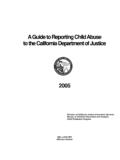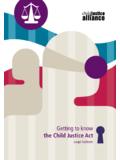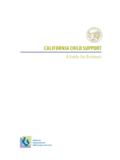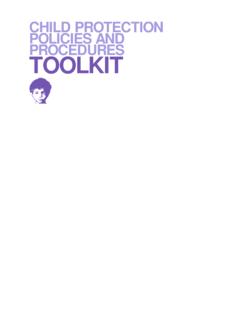Transcription of CHILD CARE PROVIDER - Internal Revenue Service
1 CHILD care PROVIDER Audit Technique Guide NOTE: This document is not an official pronouncement of the law or the position of the Service and cannot be used, cited, or relied upon as such. This guide is current through the publication date. Since changes may have occurred after the publication date that would affect the accuracy of this document, no guarantees are made concerning the technical accuracy after the publication date. Publication date 3/2009 Table of Contents Definitions: Types of CHILD care 4 5 Income 5 5 Income Audit 6 6 Income from 8 Reconstruction Methods to Verify Income or Reconstruct 8 Food Program Reimbursements (CACFP) .. 11 Other 12 Expense Issues:.. 12 Introduction to Expenses Determining the deductible amount under IRC Section 162 and the business usage percentage in CHILD care PROVIDER 12 Substantiation Requirements of IRC Section 274(d) and IRC Regulation 13 14 Challenges:.. 14 IRC Section 15 Special depreciation 15 Listed 15 Vehicle (Car and Truck) 16 Travel, Meals, 17 Food 18 Business Use of the Home.
2 20 20 Requirements to Qualify for Business Use of Home Deduction for Day care Facilities (Regulatory).. 20 Limitation on Deduction (Regulatory).. 20 Regular Use Versus Exclusive 21 Determining Business 21 Figuring the Allowable Deduction:.. 23 Tax Exempt Income Used for Payment of Housing Used in Day care :.. 23 Depreciation of the Home .. 25 Modifications to the Home .. 25 Sale of 25 26 26 Bad 26 Commissions and 26 Employee Benefit Program/Pension and Profit 27 27 Office Expenses and 27 28 Start-Up Costs (paid or incurred after October 22, 2004).. 28 Page 2 Organizational Costs of Corporations or Partnerships (paid or incurred after October 22, 2004) .. 28 Telephone 29 29 Bank 29 29 Other 29 30 Employee Versus Independent 30 Exhibit A Sample 32 Exhibit B Internal Revenue Regulation (i).
3 33 Page 3 Purpose This Audit Techniques Guide (ATG) will provide information to enable examiners to effectively audit issues pertaining to CHILD care providers. The ATG will: Provide background information Identify frequent and/or unique issues Provide examination techniques Supply applicable law Definitions: Types of CHILD care Providers Kith and Kin ( care Provided by Relatives, Friends and Neighbors): These caregivers are generally the most informal type of CHILD care providers. It is often called "Kith and Kin" care and can take place in the caregiver's home or in the CHILD 's home. In some instances, the PROVIDER will be a spouse caring for his/her own children and also taking care of one or two additional children for the extra income. Others can be grandparents or other relatives, friends, or neighbors who welcome the extra money or are not paid, but are willing to look after the children.
4 This type of care is generally not under much regulatory control and in some states may be exempt from licensing requirements. These providers often believe that this income is not taxable and, therefore, need not be reported. However, this could result in both taxable income and self- employment tax. CHILD care provided in the CHILD s home by a household employee, which is discussed under In-Home care , is also a concern. Family Day care : This type of CHILD care is provided in the home of the PROVIDER , is nonmedical and is usually for less than 24 hours. Regulations differ from state to state; however, most states regulate facilities that care for more than four children. Most states require family care providers to have criminal background checks, preservice and/or ongoing training as well as state inspection on an annual or random basis. All states set minimum health, safety, and nutrition standards for providers. Where there are government regulatory requirements, the PROVIDER is required to be approved, certified, registered or licensed under the applicable state or local law.
5 [Compliance with regulatory requirements may be important as it could affect the deduction for the business use of the home (discussed later) under Internal Revenue Code ( IRC ) Section 280A(c)(4).] Contact the applicable state or local agency for their regulations, which can be found via the link cited below. CHILD care Centers: This type of CHILD care is usually provided in separate facilities apart from the owner s residence. Many CHILD care centers are organized as corporations (Form 1120), S corporations (Form 1120S) or partnerships (Form 1065). There may be more than one facility operated by a corporation or partnership. There may be one or more shareholders or partners involved in several facilities, each of which may be organized as a separate corporation or partnership. All states require CHILD care centers to be licensed, although the specifics of each will differ. Contact the applicable state or local agency for their regulations using the link below. These centers may be required to report Page 4 attendance records or other similar information.
6 They may have large commercial kitchens, playground equipment, swimming pools, and large quantities of toys In-Home care : Some children are cared for in their own homes by a paid housekeeper, maid, governess, au pair or nanny. The home caregiver is generally paid as a household employee. The parents show the wages on Schedule H attached to their Form 1040. This situation is not a CHILD care PROVIDER business. The nanny, housekeeper, etc. receives wages but does not incur expenses as a CHILD care PROVIDER . For more information see Topic 756 - Employment Taxes for Household Employees. Most states do not regulate in-home caregivers, but some states regulate nanny-placement agencies Babysitters: Lastly, babysitters provide CHILD care in the CHILD s home on an irregular basis, such as when the parents go out to an event leaving the children under the care of a college student. The income of a babysitter is taxable income. Others: There may be other types of CHILD care providers, such as after-school programs, church programs, or other tax-exempt entities.
7 These are not specifically addressed in this document The National Resource Center for Health and Safety in CHILD care and Early Education provides links to individual state's CHILD care regulations, as well as licensing and CHILD care -related contacts. Status This guide will focus on the income and expenses of a CHILD care PROVIDER . Examination of these returns may result in the following determinations: Income is frequently understated and may be paid in cash. Expenses are often overstated and may be paid in cash Record keeping is often inadequate. Issues most often adjusted include: o Gross receipts o Food reimbursement o Food expense (may include personal expenses) o Business use of home o Unusually large expenses o Supplies and miscellaneous expenses (may include personal expenses). Income Issues Introduction Whether the CHILD care PROVIDER is a babysitter, Kith & Kin type PROVIDER , a family day care operator or a CHILD care center, the income from the activity is taxable income.
8 The net income is subject to self-employment tax, if applicable, with the exception of a Page 5 PROVIDER who is organized as a separate entity, such as a corporation. The income and expenses of sole proprietors should be reported on Form 1040, Schedule C (or C-EZ), with the net income reported on Schedule SE to compute self-employment tax, if applicable. Partnerships report their income and expenses on Forms 1065 with the net income passing to the partners on Forms K-1 and reported on their Forms 1040, Schedule E, and Form SE, if applicable. Similarly, S corporations report their income and expenses on Forms 1120S and pass through the net income to their shareholders to be reported on their Forms 1040. C corporations report their income and expenses on Forms 1120. [Note: Some providers may be doing business as limited liability companies (LLCs).]
9 LLCs may be taxed as Schedule C businesses, as partnerships, or as corporations, depending on the circumstances. [See IRC Regulations , , and ] The records available will range from nonexistent to a very sophisticated electronic set of books and records depending on the size of the PROVIDER and the bookkeeping and tax knowledge of the PROVIDER . Income may be received from the parents, business entities, government subsidies, food program reimbursements including the CHILD & Adult care Food Program ( CACFP ) discussed below, and nonprofit organizations. The audit techniques used will be based on the facts and circumstances of each case. Income Audit Techniques Audit techniques required are in IRM and summarized on the Examiner s Mandatory Lead Sheet Work Paper #400 Minimum Income Probe Lead Sheet . The following provides information specific to this industry to assist in performing the various income analyses. Interview The answers to the questions below will provide you with the information that is available to verify that income is correctly reported and what sources are available to do an indirect method if necessary: Ask how the PROVIDER determined the income for the business.
10 Does the PROVIDER maintain any records of the income received? What kind of records? Does the PROVIDER have a contract with the children s parents? If yes, ask for the contract. Does the PROVIDER have a rate schedule? Is the same schedule used for all children or do some have a special rate? Determine which children have a different rate and the amount. If the PROVIDER does not have the rate schedule for the year in question, ask for the current rate schedule and then ask how it differed in the tax year under exam. What is the policy for payment when the CHILD is absent due to illness, vacation, Page 6 Does the PROVIDER get paid vacation? (Are the fees due for the period the PROVIDER takes agreed upon vacation?) Does the PROVIDER have a fee policy for when the parents drop their children off early or are late picking up the children?















